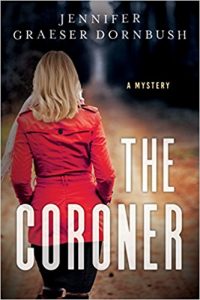How to Capitalize On An Unconventional (aka Crazy) Childhood
 Long before American television was saturated with CSI and Forensic Files, I was living my own weekly CSI adventure with my family in northern Michigan. My father was a medical examiner for three counties and my mother assisted as his office manager. They ran the office out of our home because the county was underfunded.
Long before American television was saturated with CSI and Forensic Files, I was living my own weekly CSI adventure with my family in northern Michigan. My father was a medical examiner for three counties and my mother assisted as his office manager. They ran the office out of our home because the county was underfunded.
Dad performed autopsies at the small county hospital morgue, but all the records, paperwork, and photographs were kept in our family office. Samples of blood and body tissue were stored in a basement freezer, right under the pork chops and frozen beans like some B-rated horror flick. Dinnertime conversations often revolved around the case of the week. “Let me tell you about an interesting suicide I saw today,” my dad would say. “Oh, and pass the corn, please.”
When I started writing I began to tap into my past and the treasure trove of knowledge from those decades of death investigation with my family. The Coroner novel is one result of that. And there are many more from the hundreds of stories in my memory bank. But when writing about the past, I try to keep the following things in mind:
1. Base characters on real people but give them different names, personality traits, and visual description.
In The Coroner, Dr. Emily Hartford was based on a conglomeration of myself, and my two younger sisters. Emily is little bits of all of us. My middle sister is more blood and guts oriented like Emily. My younger sister has the tenacity, style, and individuality of Emily. And I have lived in major cities, including Chicago, for most of my life, but always find myself returning home to my rural roots.
2. Use real places to help with world building.
For instance, the town of Freeport is based on my hometown of Fremont. I know, not a far cry from its original name. But that actually helped me picture the real place when I wrote. Of course, I kept the place of Chicago and I think that helps ground the story some and gives it an element of reality.
When I write I picture different places around “Freeport.” The library, the downtown, the lakes, countryside, hospital. This helps me create authentic descriptions. I also have a deep, deep love for the place where I grew up. I think that love shows through in the tone and in how Emily, Nick, and her father view Freeport. I really want Freeport to be a character unto its own.
3. Tap into the unpleasant memories.
Some of the memories I have being a coroner’s daughter are neutral, some comedic, some embarrassing, and some downright unpleasant or scary. For instance, we had a human leg in our barn for years and I was scared to into the barn alone with that leg. This was really a bummer (not to mention a bit smelly) because our childhood fort was situated right above it in the barn loft. I would fling the barn door open, flip on the light, and then run past the leg and scramble up the ladder to get to my loft fort where I could spend hours reading and holding tea parties.
Rewrite your scary childhood memories in a way that takes power away from the scary and unsavory. Keep the emotion and be true to the experience. Writing it removes the negative power it holds in your memory. Sharing makes it seem less scary.
4. Feel the fear and use it!
We all have those tangible fears like fear of heights, snakes, or tornados. But what are your biggest psychological fears? Figure it out and tap it that for your characters. One of mine is fear of missing out. I think Emily carries that same fear because of the trauma she experienced when she was left out of her mother’s death investigation. This drives everything she’s done in her life since. She’s gone full out to experience life at its fullest. Even in her romantic relationship with Brandon. He leads her into a world she would have never experienced back in Michigan.
5. Embrace the crazy.
Everyone’s childhood is unique and special. Once you can frame it this way in your mind, it becomes less embarrassing. Try to see your experiences as a view into a world that no one has ever experienced before and is dying (no pun intended) to know about. I spent many years been deeply embarrassed and disgusted by what my father did for a living. I thought it was weird and gross. This was pre-Forensic Files era when no one knew anything about forensic science and Abby Scuito wasn’t making it cool on NCIS.
Where was Abby when I was a teen!? We woulda been Insta-besties. I know it. Afterall, dead bodies sometimes slept in my garage.
6. Leave the family skeletons in the closet. We literally had a family skeleton. His name was Sam and he was a made of real human bones. He spent a good deal of time in my father’s medical practice, but in his later years ended up living in a box in our barn. Sam died of lung cancer. Or so we surmised by evidence of a cigarette dangling from his yellowed teeth bones. Sam has since gone on to enjoy the rest of his boney life in a high school biology lab.
I suspect I’ll get disagreement here, but I’m not a big fan of using fiction to launch a passive aggressive attack on family, air dirty laundry, or take revenge on a family member by making them an unsavory antagonist. Show some human decency and respect the privacy of yourself and your real life family. There’s enough other drama and dysfunction out there to go around. So, just to be clear, none of the things that happened to the Hartford family ever happened to my own mom and dad. Their circumstances, backstories, and demises are purely, 100 percent fictional!
7. If it made you cringe, use it!
Those embarrassing moments and experiences of our childhood are universal. Draw from these because they will help your audience become endeared to your characters.
I’ve had my share of embarrassing moments as a coroner’s daughter. I’ll never forget the time I was dating my now husband and his friends came over. They were in the basement hanging out when they decided to look in the fridge for some soda. Instead, they found blood vials labeled with the names and DODs of the deceased. This was simply the property of the medical examiner’s office, nothing sinister. This particular incident didn’t make it into the current novel, but one can imagine how awkward or odd it might have been for Emily, as a young teen, to have a dating life. It didn’t scare Nick away. And thankfully, not my husband either.
8. Honor the real victims.
In The Coroner, Julie Dobson’s murder is based off a girl in my hometown who was thrown from her horse, hit her head, and as a result, died. She and I were both in junior high school when this happened. There was nothing sinister about girl’s death. It was purely accidental, but the tragedy of this young girl’s early demise deeply affected my community. I wanted to memorialize this young victim. She may have died long ago, but she’s not forgotten. When I was trying to come up with a case for Emily to investigate, I started playing the “what if” game. What if a teen equestrian were suddenly found dead? What if it were a murder? Who would want her dead and why? And the rest is between the jacket cover.
—
Jennifer Graeser Dornbush is herself the daughter of a medical examiner, whose office was in her home. She investigated her first fatality, an airplane crash, when she was 10 years old. Since that first case she has had decades of on-site experience in death investigation and 360 hours of forensic training through the Forensic Science Academy. Jennifer now uses these experiences to pen crime fiction for film and TV, with a feature film God Bless the Broken Road slated for release in 2018. She has consulted on shows such as Deception, Hawaii Five-O, Prison Break, Leverage, and more. Jennifer is also member of Sisters in Crime and hosts webinars on crime writing through Writer’s Digest.
Find out more about her on her website https://www.jenniferdornbush.com/
Follow her on Twitter @JGDornbush
 Summoned from her promising surgical career first to her estranged father’s bedside, and then his post as medical examiner when his small town needs urgent help with a suspicious death, Emily Hartford discovers home is where the bodies are in this pitch perfect mystery debut.
Summoned from her promising surgical career first to her estranged father’s bedside, and then his post as medical examiner when his small town needs urgent help with a suspicious death, Emily Hartford discovers home is where the bodies are in this pitch perfect mystery debut.
Recently engaged and deeply ensconced in her third year of surgical residency in Chicago, Emily Hartford gets a shock when she’s called home to Freeport, MI, the small town she fled a decade ago after the death of her mother. Her estranged father, the local medical examiner, has had a massive heart attack and Emily is needed urgently to help with his recovery.
Not sure what to expect, Emily races home, blowing the only stoplight at the center of town and getting pulled over by her former high school love, now Sheriff, Nick Larson. At the hospital, she finds her father in near total denial of the seriousness of his condition. He insists that the best thing Emily can do to help him is to take on the autopsy of a Senator’s teen daughter whose sudden, unexplained death has just rocked the sleepy town.
Reluctantly agreeing to help her father and Nick, Emily gets down to work, only to discover that the girl was murdered. The autopsy reminds her of her many hours in the morgue with her father when she was a young teen―a time which inspired her love of medicine. Before she knows it, she’s pulled deeper into the case and closer to her father and to Nick―much to the dismay of her big city fiance. When a threat is made to Emily herself, she must race to catch the killer before he strikes again in The Coroner, expertly written and sharply plotted, perfect for fans of Patricia Cornwell and Julia Spencer Fleming.
Category: How To and Tips

























I don’t write fiction, but do use my unconventional childhood in stories, and agree with these:
5. Embrace the crazy
7. If it made you cringe, use it
Common sense tips here. Thank you.